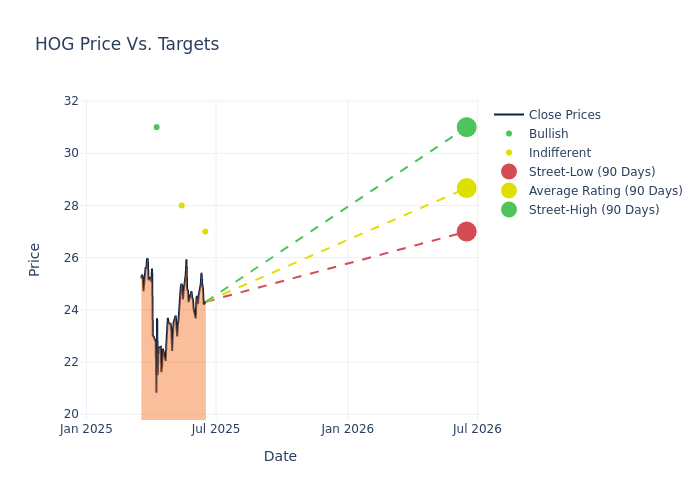Harley-Davidson Stock: A Deep Dive Into Analyst Perspectives (5 Ratings)
In the latest quarter, 5 analysts provided ratings for Harley-Davidson (NYSE:HOG), showcasing a mix of bullish and bearish perspectives.
The following table encapsulates their recent ratings, offering a glimpse into the evolving sentiments over the past 30 days and comparing them to the preceding months.
| Bullish | Somewhat Bullish | Indifferent | Somewhat Bearish | Bearish | |
|---|---|---|---|---|---|
| Total Ratings | 1 | 0 | 4 | 0 | 0 |
| Last 30D | 0 | 0 | 1 | 0 | 0 |
| 1M Ago | 0 | 0 | 0 | 0 | 0 |
| 2M Ago | 0 | 0 | 1 | 0 | 0 |
| 3M Ago | 1 | 0 | 2 | 0 | 0 |
The 12-month price targets, analyzed by analysts, offer insights with an average target of $28.0, a high estimate of $31.00, and a low estimate of $26.00. Observing a 0.9% increase, the current average has risen from the previous average price target of $27.75.

Decoding Analyst Ratings: A Detailed Look
The standing of Harley-Davidson among financial experts is revealed through an in-depth exploration of recent analyst actions. The summary below outlines key analysts, their recent evaluations, and adjustments to ratings and price targets.
| Analyst | Analyst Firm | Action Taken | Rating | Current Price Target | Prior Price Target |
|---|---|---|---|---|---|
| James Hardiman | Citigroup | Raises | Neutral | $27.00 | $24.00 |
| Craig Kennison | Baird | Raises | Neutral | $28.00 | $26.00 |
| Brandon Rolle | DA Davidson | Announces | Buy | $31.00 | - |
| Craig Kennison | Baird | Lowers | Neutral | $26.00 | $32.00 |
| James Hardiman | Citigroup | Lowers | Neutral | $28.00 | $29.00 |
Key Insights:
- Action Taken: Analysts respond to changes in market conditions and company performance, frequently updating their recommendations. Whether they 'Maintain', 'Raise' or 'Lower' their stance, it reflects their reaction to recent developments related to Harley-Davidson. This information offers a snapshot of how analysts perceive the current state of the company.
- Rating: Unveiling insights, analysts deliver qualitative insights into stock performance, from 'Outperform' to 'Underperform'. These ratings convey expectations for the relative performance of Harley-Davidson compared to the broader market.
- Price Targets: Gaining insights, analysts provide estimates for the future value of Harley-Davidson's stock. This comparison reveals trends in analysts' expectations over time.
Understanding these analyst evaluations alongside key financial indicators can offer valuable insights into Harley-Davidson's market standing. Stay informed and make well-considered decisions with our Ratings Table.
Stay up to date on Harley-Davidson analyst ratings.
Unveiling the Story Behind Harley-Davidson
Harley-Davidson is a leading global manufacturer of heavyweight motorcycles across the custom, cruising, and touring segments, as well as related merchandise, parts, and accessories. In recent years, the firm has expanded into the adventure touring market with its Pan America model and into electric with the LiveWire brand. Its captive finance arm, Harley-Davidson Financial Services, provides wholesale financing to dealers and retail financing and insurance brokerage services to customers. Harley captured around 37% of the heavyweight domestic market in 2024.
Harley-Davidson: A Financial Overview
Market Capitalization Analysis: With an elevated market capitalization, the company stands out above industry averages, showcasing substantial size and market acknowledgment.
Revenue Growth: Harley-Davidson's revenue growth over a period of 3M has faced challenges. As of 31 March, 2025, the company experienced a revenue decline of approximately -23.15%. This indicates a decrease in the company's top-line earnings. As compared to competitors, the company surpassed expectations with a growth rate higher than the average among peers in the Consumer Discretionary sector.
Net Margin: Harley-Davidson's financial strength is reflected in its exceptional net margin, which exceeds industry averages. With a remarkable net margin of 10.01%, the company showcases strong profitability and effective cost management.
Return on Equity (ROE): Harley-Davidson's ROE surpasses industry standards, highlighting the company's exceptional financial performance. With an impressive 4.19% ROE, the company effectively utilizes shareholder equity capital.
Return on Assets (ROA): The company's ROA is a standout performer, exceeding industry averages. With an impressive ROA of 1.1%, the company showcases effective utilization of assets.
Debt Management: With a high debt-to-equity ratio of 2.31, Harley-Davidson faces challenges in effectively managing its debt levels, indicating potential financial strain.
Analyst Ratings: What Are They?
Benzinga tracks 150 analyst firms and reports on their stock expectations. Analysts typically arrive at their conclusions by predicting how much money a company will make in the future, usually the upcoming five years, and how risky or predictable that company's revenue streams are.
Analysts attend company conference calls and meetings, research company financial statements, and communicate with insiders to publish their ratings on stocks. Analysts typically rate each stock once per quarter or whenever the company has a major update.
Some analysts will also offer forecasts for metrics like growth estimates, earnings, and revenue to provide further guidance on stocks. Investors who use analyst ratings should note that this specialized advice comes from humans and may be subject to error.
Which Stocks Are Analysts Recommending Now?
Benzinga Edge gives you instant access to all major analyst upgrades, downgrades, and price targets. Sort by accuracy, upside potential, and more. Click here to stay ahead of the market.
This article was generated by Benzinga's automated content engine and reviewed by an editor.